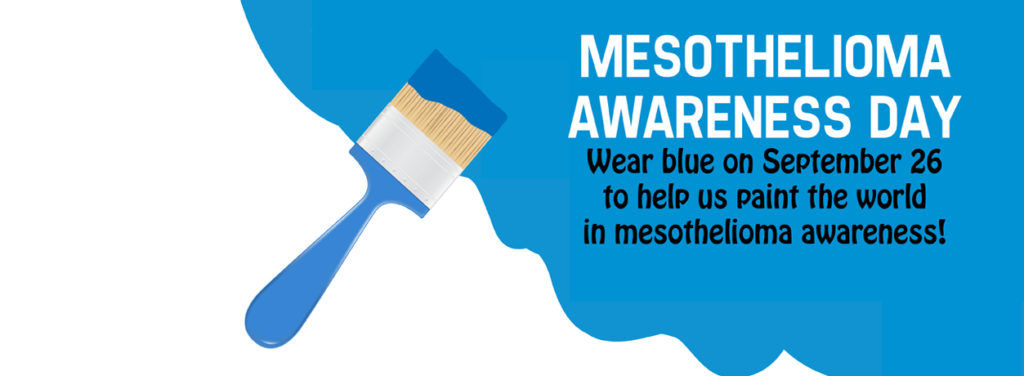Go MAD & paint your world blue on Mesothelioma Awareness Day
September 26, 2017 marks the 13th annual Mesothelioma Awareness Day (MAD).
Founded in 2004 by the Mesothelioma Applied Research Foundation, MAD aims to raise both awareness of, and funds for mesothelioma – an aggressive form of cancer that affects the lining of the lungs, heart and abdomen – to help identify ways to treat the disease, in order to ultimately find a cure.
This September 26, MAD is encouraging you to “paint the world blue” by wearing blue, and to urge your friends, family members and colleagues to do the same.
MAD is encouraging all participants to take and share photos across social media platforms, using the hashtag #curemeso, explaining why you are wearing blue to raise awareness of mesothelioma in order to raise funds for new treatments and to find a cure for the devastating cancer.
Unlike some cancers whose cause is unknown, mesothelioma is mainly caused by exposure to asbestos, or asbestos poisoning.
In a piece written by the Director of the National Centre for Asbestos Related Diseases, Western Australia, for ABC Health & Wellbeing, mesothelioma may take 20 to 40 years, or longer to develop, and relatively little asbestos exposure is required to develop the disease.
Symptoms of mesothelioma can include:
- Dry cough or wheezing
- Shortness of breath
- Respiratory complications
- Pain in the chest or abdomen
- Fever or night sweats
- Fluid around the lungs
- Fatigue
- Muscle weakness.
According to the Asbestos Diseases Research Institute Australia website, Australia has the second-highest mesothelioma death rate world-wide, with more than 10,000 deaths since the 1980’s. Moreover, an additional 25,000 people are expected to die as a direct result of mesothelioma in the ensuing four decades, unless new treatments and a cure can be found.
According to the latest Australian Bureau of Statistics data, in 2014, 692 Australians died from mesothelioma, while an estimated 18,000 Australians will develop mesothelioma by 2021.
With a substantial 8-in-10 Australian deaths from mesothelioma occurring in men, this demographic is at much higher risk of developing the disease than women.
Globally, Australia was one of the highest users of asbestos per capita, with asbestos products among the most popular used in building, construction, mining and engineering, among other industries, up until the mid-1980s when the product was phased out.
Asbestos-containing products used in Australia, included:
- flat and corrugated sheeting
- cement pipes
- insulation
- floor tiles
- adhesives
- roofing
- automobile parts such as brake pads
- textiles
- textured paints.
Builders, transport workers, miners, millers, cement factory workers, plumbers, insulators, electricians, and mechanics are considered at highest risk of contact with asbestos.
Today, despite the ban on importing asbestos, and asbestos-containing products which came into effect in Australia at the end of 2003, there is still a small risk for worker exposure to asbestos.
Safe Work Australia warns workers to be careful of all construction materials, insulation products, gaskets, friction brake products, vehicle and plant equipment installed, built, manufactured, commissioned or designed prior to January 1, 2004.
To date, there is no cure for mesothelioma, but treatments are available to slow its spread and reduce symptoms. Nearly all mesothelioma patients have treatment options – whether curative or palliative, that can extend survival, alleviate pain, and increase quality of life.
According to the Mesothelioma + Asbestos Awareness Center, “Each mesothelioma case is considered individually and there is no singular prescribed roadmap for the management of malignant mesothelioma.
“What’s best for each individual patient will depend on any number of factors. Diagnostic procedures such as X-rays, MRIs, CT scans and biopsies will be used to determine these factors – tests that assist GPs and/or oncologists to determine the best treatment for each individual and their particular circumstances,” the organisation said.
The most regularly used treatments for mesothelioma today, include:
- Surgery
- Chemotherapy
- Radiation Therapy.
So, be sure to show your support for this worthy cause by painting your world blue this Mesothelioma Awareness Day.
If you are experiencing any symptoms of mesothelioma, and/or suspect you may have been exposed to asbestos, speak to your doctor today.
To learn more about MAD, head here.
To learn more about mesothelioma, head here.

